ANTI-POP II
With works by Peter Bonde, Christian Eisenberger, Anna K.E., Boris Lurie, Florian Meisenberg, Manfred Peckl, Chloe Piene, Anselm Reyle, Rudolf Schwarzkogler, Luise-Finn Tismer, Anne-Mie Van Kerckhoven, Gabriel Vormstein, Thomas Zipp and Egon Zippel
15 MAR until 24 APR 2025
Opening – 14 MAR 2025, 6-9 pm
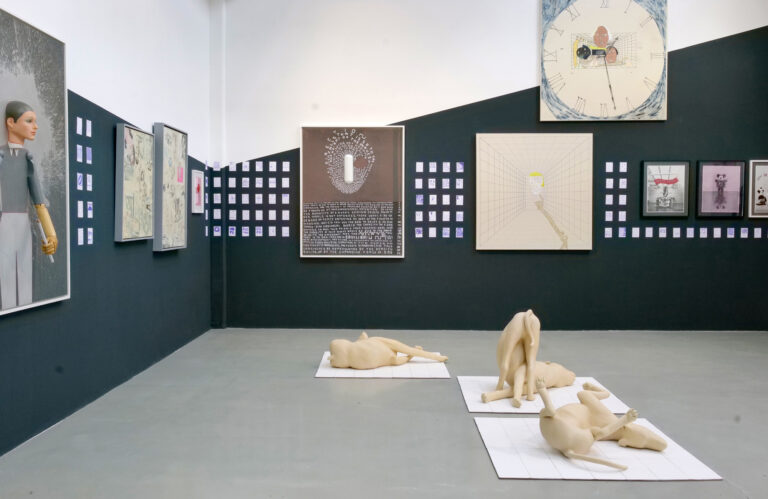
ANTI-POP II,
Group show at the Galerie Barbara Thumm, exhibition view 2025, curated by Thomas Zipp and Barbara Thumm,
Courtesy of Galerie Barbara Thumm, Photo: Gerret Schultz
Galerie Barbara Thumm is delighted to present the exhibition “Anti-Pop II”, a dynamic collaboration with Thomas Zipp. This partnership not only marks the beginning of an exciting journey between Thomas and Barbara but also paves the way for many more exciting projects to come, including an upcoming solo exhibition by Zipp in the fall at Galerie Barbara Thumm. Thomas Zip is an artist and professor at the der Universität der Künste Berlin. The following note, written by Thomas himself, offers a glimpse into his curatorial vision for this show.
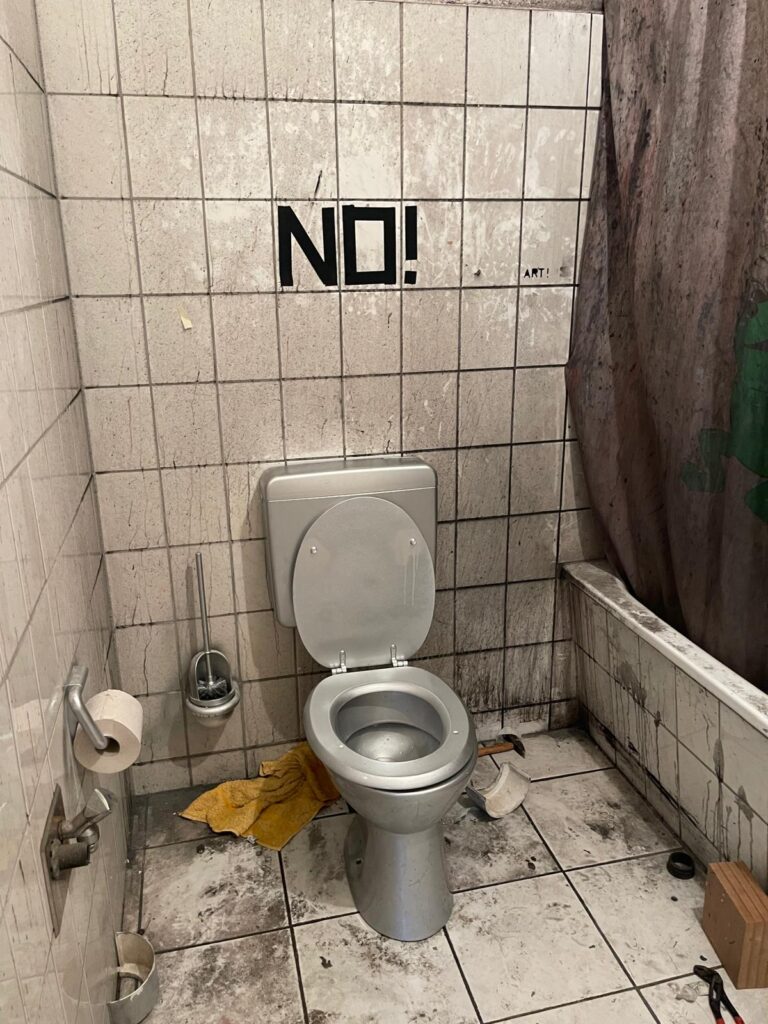
ANTI-POP II, Group show at the Galerie Barbara Thumm 2025, curated by Thomas Zipp and Barbara Thumm, Courtesy of Galerie Barbara Thumm
Curatorial Statement
“Anti-Pop II” channels the radical defiance of the NO!art movement into the present, confronting the commodification of contemporary art through raw, urgent, and often discomforting aesthetics. The exhibition traces a lineage from Boris Lurie’s politically charged rejection of market-friendly art to a contemporary generation of artists resisting aesthetic conformity, commercial trends, and sanitized cultural narratives. “Anti-Pop II” features a wide array of artists, including Peter Bonde, Christian Eisenberger, Anna K.E., Boris Lurie, Florian Meisenberg, Manfred Peckl, Chloe Piene, Anselm Reyle, Rudolf Schwarzkogler, Luise-Finn Tismer, Anne-Mie van Kerckhoven, Gabriel Vormstein, Thomas Zipp, and Egon Zippel.
At its core, NO!art was an anti-Pop, anti-establishment movement founded in 1959—a visceral counterpoint to the sleek, consumer-driven optimism of Warhol and Lichtenstein. It rejected spectacle in favor of raw social critique and existential protest. Today, when art operates both as luxury commodity and viral spectacle, the urgent question resurfaces: what does artistic resistance look like now?
This exhibition brings together artists who, in diverse ways, challenge traditional expectations of beauty, success, and political engagement in art. From distorted figuration to material excess, from satirical self-referentiality to politically charged imagery, “Anti-Pop II” is about an art that refuses to conform, refuses to sell out, refuses to be polite.
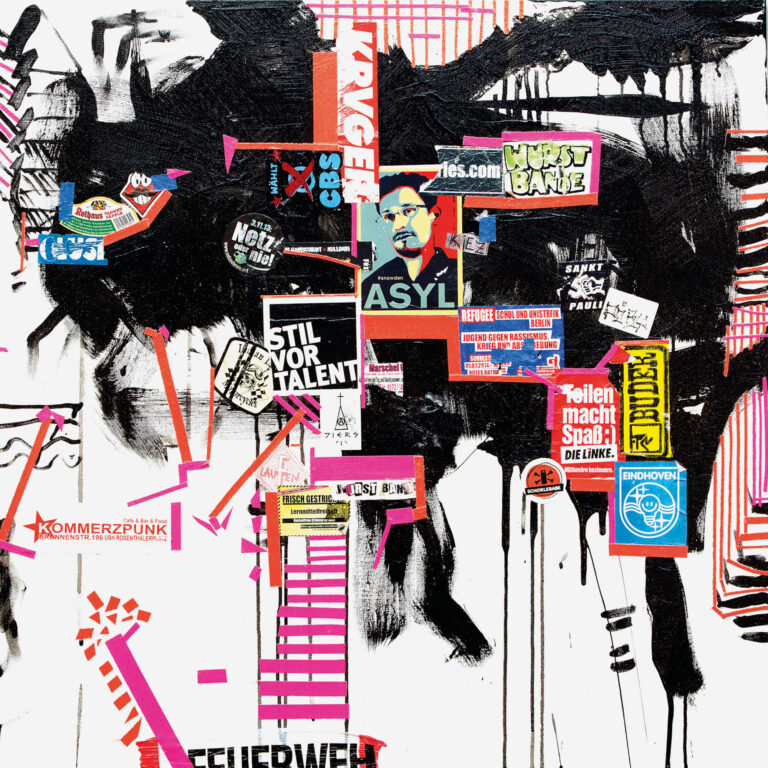
Egon Zippel,
ASYL, 2016,
Stickers from Berlin and signaling tape from NYC, acrylic paint on canvas, 76x76cm,
Courtesy of the artist and Galerie Barbara Thumm
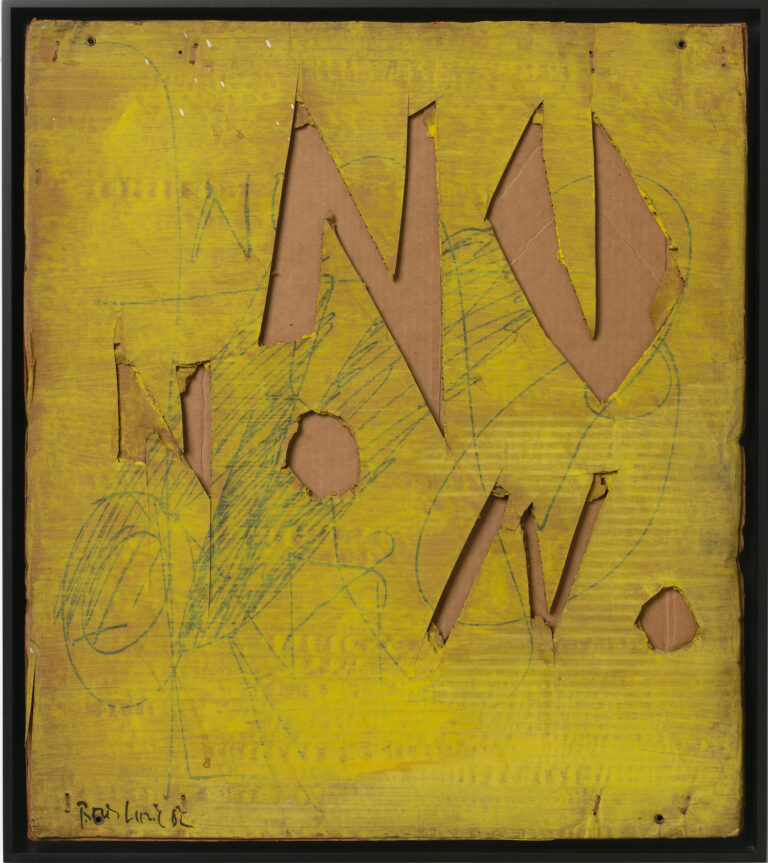
Boris Lurie,
NOs Cut Into Cardboard (Relief), 1962,
Acrylic and ink on cardboard 63.5 x 55.9 cm,
Courtesy of the artist and Galerie Barbara Thumm
Key Themes & Exhibition Sections
- “NO!art Redux: Resistance & Refusal”
- Featuring Lurie’s original collages, this section reintroduces NO!art’s radical rejection of Pop alongside contemporary responses that resist commodification.
- “Aesthetics of Rebellion: Ugly, Raw & Unfiltered”
- Works that challenge traditional ideas of beauty, embracing violence, distortion, and material excess.
- “Irony vs. Sincerity: The Post-Pop Dilemma”
- Can artists critique commercialism while still participating in it? This section examines the tension between sincerity and self-aware spectacle.
- “Crisis Capitalism & the New Art Market”
- How has hyper-commercialization turned anti-establishment aesthetics into a marketable commodity? This section questions whether artistic resistance is still possible in a system that profits from its own critique.
Installation & Atmosphere
The exhibition space itself disrupts the sanitized “white cube” experience. Walls are layered with collaged protest materials, distorted mirrors, and harsh industrial lighting. Visitors navigate an environment that is both seductive and hostile, forcing them into confrontation with the artworks rather than passive consumption.
Archival NO!art footage is interwoven with interviews to contemporary artists, forging a direct dialogue between past and present. A sound installation—layering voices from historical protest movements, financial market speculation, and artist manifestos—fills the space, creating an atmosphere of unease and urgency.
Conclusion: Why Now?
As contemporary art becomes ever more entangled in luxury markets, branding, and spectacle, the ethos of NO!art is more urgent than ever. “Anti-Pop II” is not just an exhibition—it is a call to arms, challenging viewers to reconsider the boundaries between art, politics, and capital.
By bringing together a generation of artists who reject aesthetic conformity and resist commodification, “Anti-Pop II” reaffirms art’s potential as a site of defiance, critical inquiry, and unfiltered expression.
Jo Baer
15 MAR until 24 APR 2025
Opening – 14 MAR 2025, 6-9 pm
Jo Baer (b. 1929, Seattle, US) was a transformative figure in the art world, reshaping Minimalism and becoming a key player in the avant-garde movement of 1960s New York City. Renowned for the precision and intellectual depth of her work, she navigated a male-dominated field, earning recognition for her ability to push the boundaries of contemporary art.
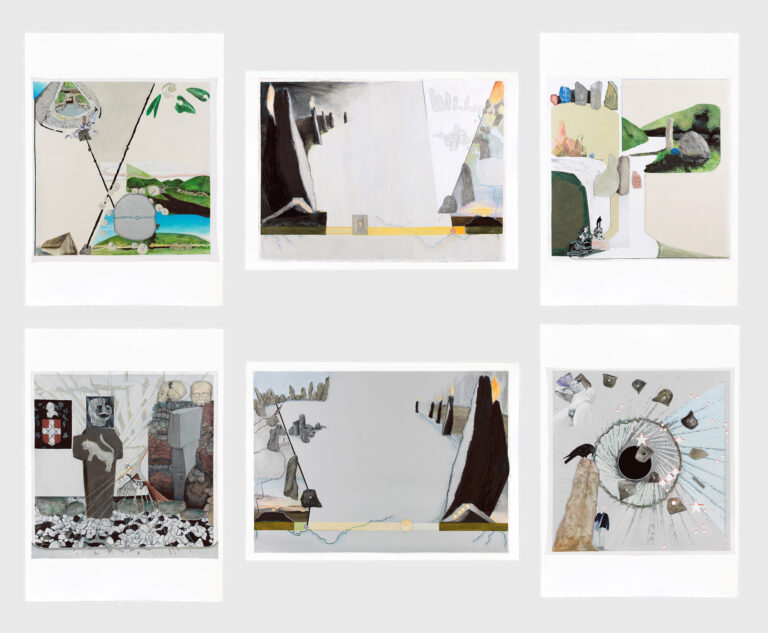
Jo Baer, In the Giclée-ed Land of the Giants, 2015, 6 Giclée prints, Epson Ultrachrome Ink on Fabriano Artistico E.W./G.F. (Extra White / Grain Fin), 300 g/qm paper, Courtesy the artist and Galerie Barbara Thumm.
By the mid-1970s, Baer made a bold, defining shift in her artistic practice, moving away from Minimalism to explore deeper, more layered forms of expression. In 1975, she relocated to County Louth, Ireland, where she spent seven years living in a Norman castle. Drawing inspiration from the local landscape and ancient mythologies, this marked the beginning of her exploration into „radical figuration“—a style she developed alongside a growing interest in the intersection of time, history, and the natural world. Baer’s 1983 essay, “I Am No Longer an Abstract Artist,” formally signaled her departure from abstraction and embrace of figurative imagery.
Galerie Barbara Thumm is honored to present this solo exhibition as a tribute to Jo Baer’s extraordinary life and legacy. Baer was a longtime collaborator with the gallery, debuting her first solo exhibition here in 2010. Over the years, the gallery played a significant role in establishing her figurative work in Europe, contributing to its placement in international collections and ensuring it received the recognition it deserved. In 2013, Baer’s series “In the Land of the Giants” was showcased at the Stedelijk Museum in Amsterdam, a city she called home for over four decades. This exhibition was a pivotal celebration of her figurative work by a European institution.
The series was later shown at Galerie Barbara Thumm (2013) and the Whitney Biennial (2017). Notably, the Whitney Museum acquired one of the works for its collection, marking a significant moment in Baer‘s return to the U.S. art scene as a figurative artist. The current exhibition at Galerie Barbara Thumm includes preliminary drawings that Baer made for this body of work, inspired by the Neolithic megalithic monuments of Ireland. Additionally, we are presenting an exclusive, limited-edition portfolio of Giclée prints from the series, featuring an introduction by John Ros and signed and numbered by the artist herself. This rare edition of 15 offers collectors a great possibility to appreciate some of Baer’s most significant works.
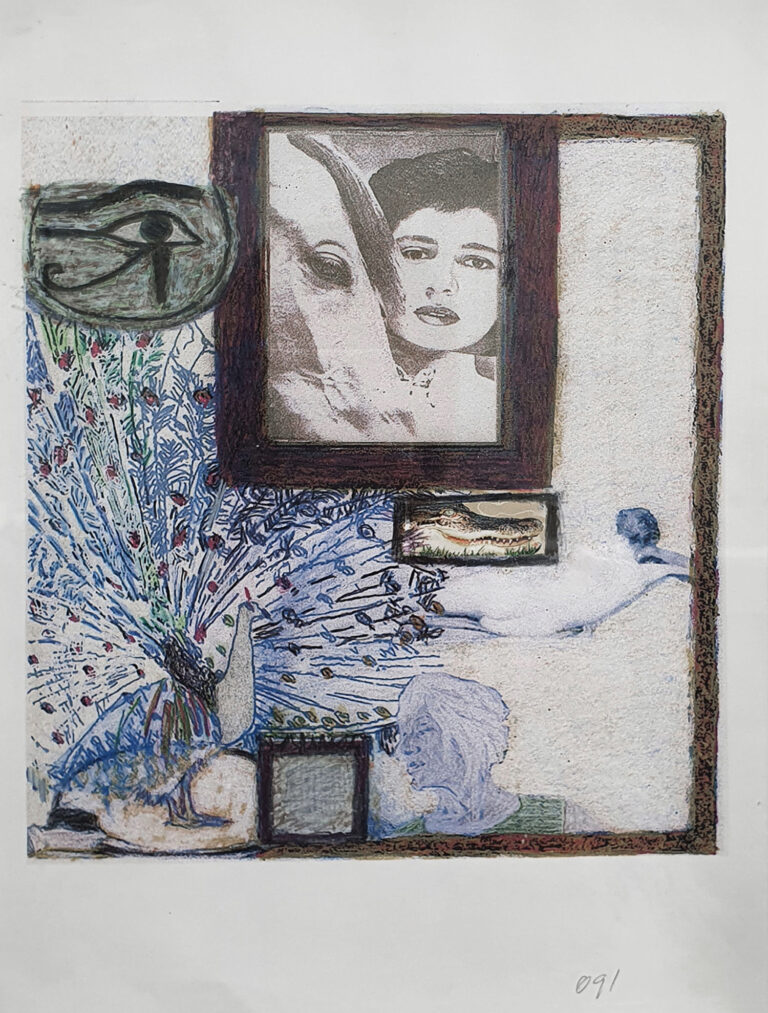
Jo Baer, Altar of the Egos (Through a Glass Darkly) – Drawing, 2002, Injekt print with colored pencil on paper, Courtesy the artist and Galerie Barbara Thumm.
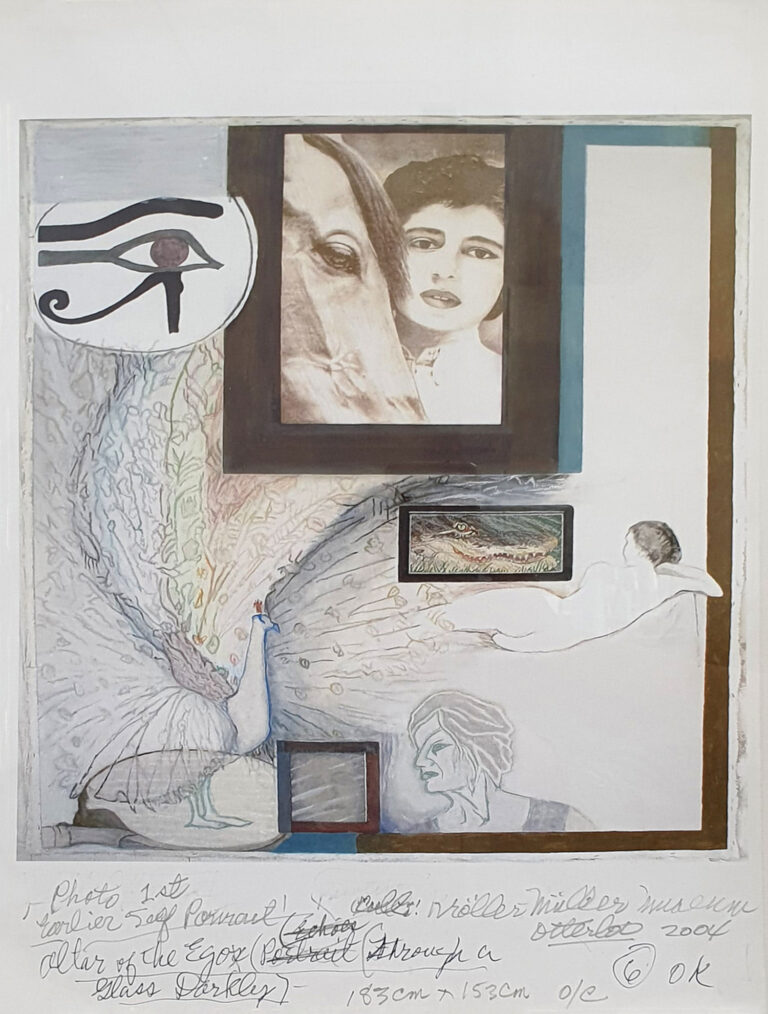
Jo Baer, Altar of the Egos (Through a Glass Darkly) – Drawing, 2004, , Injekt print with colored pencil on paper, Courtesy the artist and Galerie Barbara Thumm
The exhibition also features three exceptional preparatory vellum sketches from the early 1990s, which Baer created as studies for collages that would become some of her key paintings. Furthermore, the series of drawings titled “Altar of the Egos (Through a Glass Darkly)” presents an unusual study for a later self-portrait, combining collage techniques with personal and mythological symbolism. Among the motifs are the ancient Egyptian Eye of Horus, a symbol of protection and healing, and the silhouette of a blue peacock, representing beauty, rebirth, and royalty. These elements are paired with portraits of Baer at various stages of her life, forming an intimate self-reflection that led to one of her earliest selfportraits, acquired by the Kröller-Müller Museum in the Netherlands for its collection.
This exhibition offers a rich overview of some of Jo Baer’s most distinctive works following her shift to figuration, celebrating her enduring legacy and her long-standing relationship with the gallery.
Throughout her career, Baer held numerous solo exhibitions at renowned institutions, including the Camden Arts Centre, London (2015); the Stedelijk Museum, Amsterdam (2013, 1999); Museum Ludwig, Cologne (2013); Van Abbemuseum, Eindhoven (2009, 1986, 1978); Dia Center for the Arts, New York (2002); and the Whitney Museum of American Art, New York (1975). Her work has also been featured in group exhibitions and biennials, including the 31st Bienal de São Paulo, Brazil (2014); Busan Biennale, Korea (2012); and MoMA, New York (2017, 2016, 2008). Her art is held in prestigious public collections worldwide, such as the Museum of Modern Art, New York; Tate Gallery, London; and the Museum für Moderne Kunst, Frankfurt.
Text by: Susana Turbay Botero
